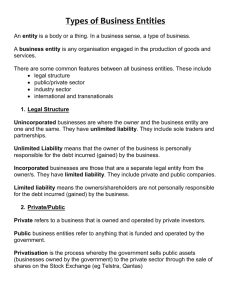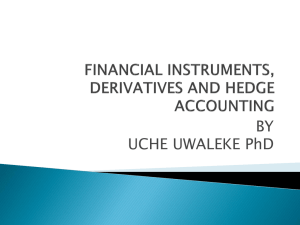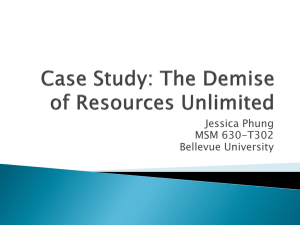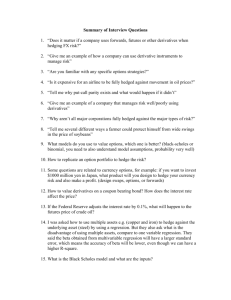Supplement to DCL on hedge accounting
advertisement
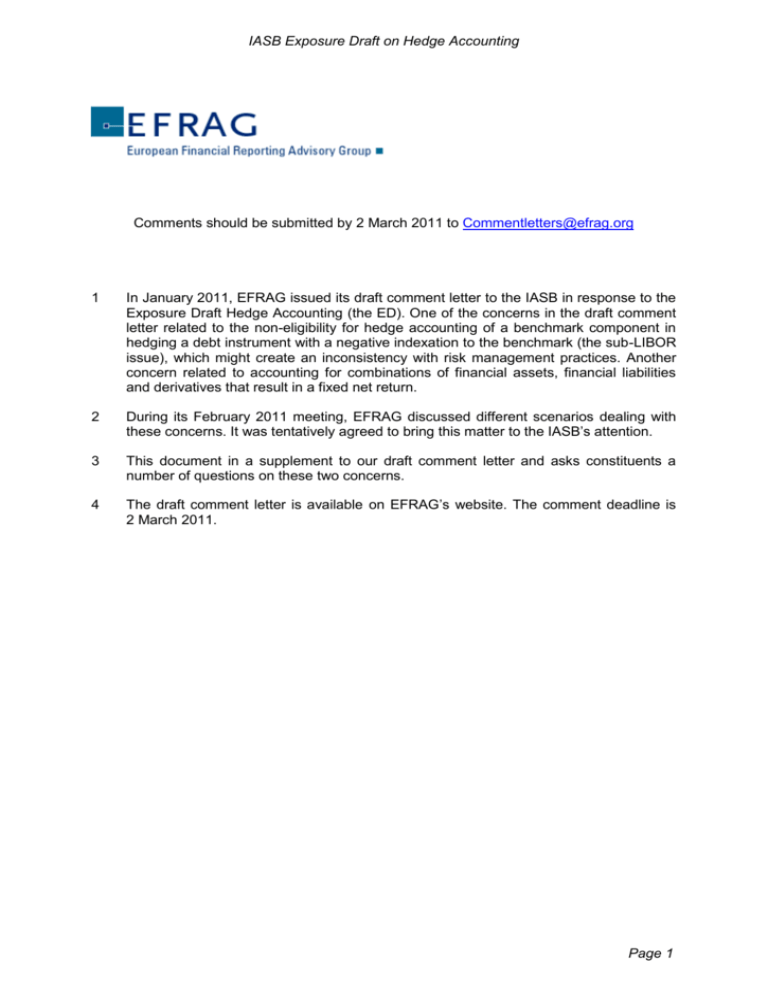
IASB Exposure Draft on Hedge Accounting Comments should be submitted by 2 March 2011 to Commentletters@efrag.org 1 In January 2011, EFRAG issued its draft comment letter to the IASB in response to the Exposure Draft Hedge Accounting (the ED). One of the concerns in the draft comment letter related to the non-eligibility for hedge accounting of a benchmark component in hedging a debt instrument with a negative indexation to the benchmark (the sub-LIBOR issue), which might create an inconsistency with risk management practices. Another concern related to accounting for combinations of financial assets, financial liabilities and derivatives that result in a fixed net return. 2 During its February 2011 meeting, EFRAG discussed different scenarios dealing with these concerns. It was tentatively agreed to bring this matter to the IASB’s attention. 3 This document in a supplement to our draft comment letter and asks constituents a number of questions on these two concerns. 4 The draft comment letter is available on EFRAG’s website. The comment deadline is 2 March 2011. Page 1 IASB Exposure Draft on Hedge Accounting Hedges of sub-LIBOR financial instruments Notes to constituents 1 If a component of the cash flow of a financial asset or financial liability is designated as hedged item, that component must be less than or equal to the total cash flows of the asset or liability (paragraphs B24-B26 of the ED). We note that the ED is not amending the requirements of IAS 39 on this specific topic (paragraphs AG99C and AG99D) and note that these requirements are currently carved out from the EU endorsement of IAS 39. 2 This causes an issue for hedging relationships where the effective interest rate of a financial instrument is below a benchmark interest rate (e.g. LIBOR) and in which the entity wants to designate as a hedged item the change in cash flows or fair value attributable to the change in the benchmark interest rate. The issue has the potential to affect the representation in the financial statements of a significant part of the risk management activities of the banks whose liabilities have a negative indexation to the benchmark. 3 EFRAG notes that designating the benchmark component as a hedged item is a risk management practice frequently adopted by financial institutions when applying macro hedging. In particular, certain types of deposits that are designated as hedged item are often benchmarked at LIBOR minus a spread. Similarly, banking supervisors may require banks to invest in sovereign debt, which will have a yield that is below LIBOR. Hedging a sub-LIBOR financial instrument 4 The IASB considered two examples when discussing the general hedge accounting requirements. Example 1 considered an asset with total cash flows equal to 103, i.e. a principal amount of 100 plus interest at a fixed rate of 3%. When the asset was originated, the LIBOR benchmark interest rate was 4%. 5 The entity’s risk management policy is to hedge the risk of changes in the fair value of the asset (principal plus interest) that are due to changes in LIBOR (excluding the margin). It enters into an interest rate swap on which the entity will pay a fixed rate of 4% and will receive a floating interest of LIBOR (i.e. without margin). 6 In this example, the fixed rate of the asset can be split at origination into two components: LIBOR minus a spread of 1%. If the LIBOR would decrease below the absolute value of this spread (i.e. below 1%) then the net cash flows of the combined exposure of ‘asset plus swap’ would be negative, as shown on the bottom line of the Page 2 IASB Exposure Draft on Hedge Accounting following table. As a result, the entity would have to pay interest on the asset it is holding. The IASB considered that this outcome would be inconsistent with the economics of the hedged instrument. LIBOR level Asset Pay leg Receive leg Net return 4.0% 3.0% -4.0% 4.0% 3.0% 1.0% 3.0% -4.0% 1.0% 0.0% 0.5% 3.0% -4.0% 0.5% -0.5% 7 In example 2, an entity has a liability on which it pays a floating interest, i.e. LIBOR minus a spread of 1%. When the liability was originated, LIBOR was 4%. The liability includes a floor, which means that if LIBOR decreases below the absolute value of the spread (i.e. below 1%), the interest rate on the instrument could not become negative. 8 The entity’s risk management policy is to hedge the risk of changes in the fair value of the liability (principal plus interest) that are due to changes in LIBOR (excluding the margin). It enters into an interest rate swap on which the entity will pay a fixed rate of 4% and will receive floating interest of LIBOR (i.e. without margin). 9 If LIBOR were to decrease below the absolute value of spread on this liability (i.e. below 1%), then the net cash flows of the combined exposure of ‘liability plus swap’ would lead to an increase in the interest the entity should pay. As illustrated in the third line of the table below, when Libor ranges between 0% and 1% the interest payments after the effects of hedging behave like a ‘reverse floater, i.e. the hedged interest expense moves opposite to market levels of interest for a hedge that would otherwise lock in the interest by swapping it from floating to fixed. The IASB believed that this outcome was not in line with the economic substance of the transaction. Hence the IASB considered that designation of a Libor risk component in an interest rate bearing instrument that is priced sub-Libor is inappropriate. LIBOR level Liability Pay leg Receive leg Net return 4.0% -3.0% -4.0% 4.0% -3.0% 1.0% 0.0% -4.0% 1.0% -3.0% 0.5% 0.0% -4.0% 0.5% -3.5% Page 3 IASB Exposure Draft on Hedge Accounting We note here that the floor in the liability could give rise to hedge ineffectiveness, i.e. the net return would not be fixed at -3.0% in all scenarios. 10 Under the proposals of the ED, it would not be possible to designate as hedged item the variability of the cash flows of the asset (example 1) or the liability (example 2) that are attributable to a change in LIBOR. However the entity would be allowed to designate as hedged item the changes in the total cash flows of the asset or the liability (i.e. the principal plus the interest component at LIBOR-1%) that are attributable to LIBOR. Such hedge would create a degree of ineffectiveness that could be reduced by designating the hedge ratio other than 1 to 1. Questions to constituents 11 Do constituents believe that hedging occurs frequently, in practice in situations similar to the one described in examples 1 and 2, above? If so, could you please explain the underlying fact pattern? 12 Do constituents have any other concerns regarding the requirement in the Exposure Draft in this respect? EFRAG’s response 13 EFRAG believes that financial instruments with a rate of return that is below LIBOR are quite common (e.g. sovereign debt). From a risk management point of view, many entities hedge the interest rate exposures related to these financial instruments using both individual hedges and macro hedges. Given the importance of these types of hedging transactions and in the light of the objective of the hedge accounting proposals, we believe that the IASB should reconsider this issue. Page 4 IASB Exposure Draft on Hedge Accounting Accounting for combinations of financial assets, financial liabilities and derivatives that result in a fixed net return 1 In discussing the general hedge accounting requirements the IASB did not considered example below, in which an entity locks in a net margin for risk management purposes. 2 An entity’s internal risk management is to manage the interest risk on a fair value basis by reference to the interbank interest rates. For this purpose, it enters into a hedging transaction to lock-in the interest margin on the asset and the associated funding. 3 Consider an example whereby the bank holds a liability on which it pays a fixed rate of 1.0%. The entity grants a loan at a floating rate of US Prime minus 0.3%. In accordance with the entity’s risk management strategy, then entity enters into a swap to lock the margin it will earn on the aggregated exposure of the asset and the liability. It enters into a swap on which it will pay US Prime and receive a fixed rate of 1.5%. 4 If the US Prime benchmark interest rate were to decrease below the absolute value of the spread, the net cost on the liability would become positive (i.e. the entity would receive interest) and the net return on the asset would become negative (i.e. the entity would have to pay interest). Nevertheless, and as shown in the table below, at an aggregated level, the entity would have managed to lock the interest margin in accordance with its risk management strategy. 5 Pay leg Receive leg Net liability + swap Asset Net return -1.0% -1.0% 1.5% -0.5% 0.7% 0.2% 0.5% -1.0% -0.5% 1.5% 0.0% 0.2% 0.2% 0.0% -1.0% 0.0% 1.5% 0.5% -0.3% 0.2% US Prime level Liability 1.0% The risk management strategy regards the cash flows of the asset, the liability and the swap as a combined exposure from which the entity is earning a fixed amount of 20 basis points in all the possible scenarios. Page 5 IASB Exposure Draft on Hedge Accounting 6 7 Under current IAS 39 and under the ED, an entity could designate the following types of hedges: (a) The swap could be designated as a fair value hedge of the liability (i.e. the combined exposure would be based on a floating benchmark); and (b) The swap could be designated as a cash flow hedge of the asset (i.e. the combined exposure would be fixed). However, it is not possible to apply hedge accounting to the natural offsetting of the cash flows of the combined financial asset, financial liability and the swap, because strictly this would neither be a fair value hedge nor a cash flow hedge. Questions to constituents 8 Could constituents please provide examples of financial assets without a floor (i.e. the holder of the financial asset might need to pay interest to the issuer)? 9 Do constituents believe that a financial asset that is indexed to a benchmark with a negative offset (e.g. US Prime minus 0.3%) would qualify for measurement at amortised cost under IFRS 9? If so, why? 10 Do constituents believe that a form of hedge accounting should also be permitted in the example above? If so, how would that hedge accounting work? EFRAG’s response 11 Given the importance of these types of hedging transactions and in the light of the objective of the hedge accounting proposals, we believe that the IASB should reconsider this issue. Page 6




